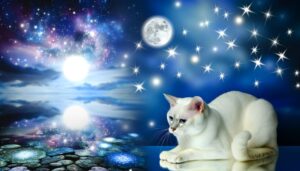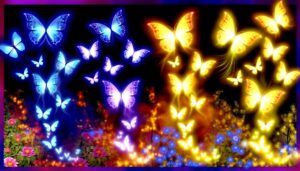Spiritual Meaning of Color Purple: Intuition and Royalty
The color purple embodies a rich spiritual meaning, revered historically for its association with royalty, nobility, and divine wisdom. Its origins from rare and costly dyes have cemented its symbolic connection to wealth, power, and sacred rituals.
More profoundly, purple straddles the domains of passion and tranquility, acting as a balance between the physical and spiritual worlds. Linked to the crown chakra, it enhances spiritual connection and enlightenment.
Purple’s high-frequency vibration supports inner peace and healing, making it integral in meditation and religious practices. Discover more about how this mystic hue can transform your spiritual experience.
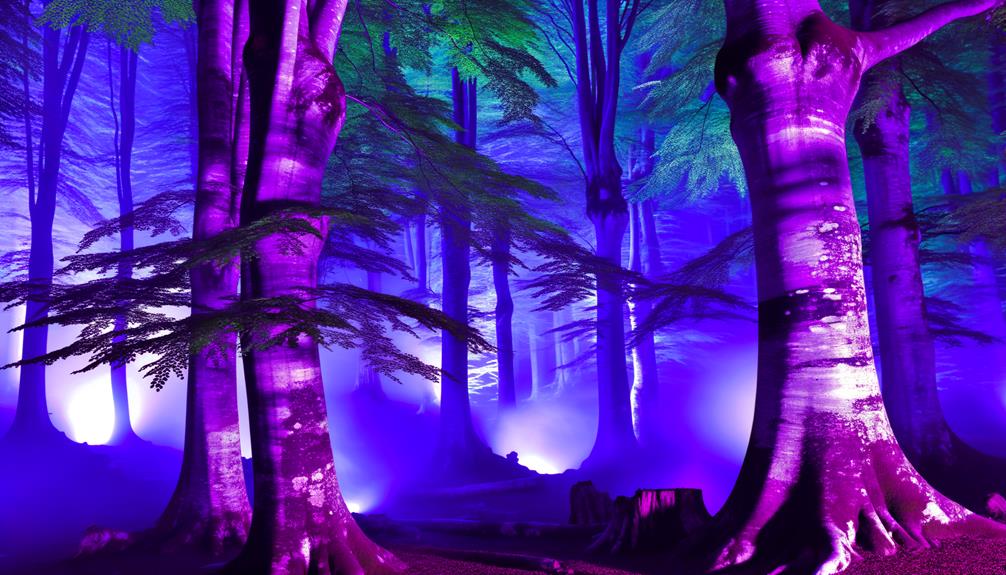
Spiritual Meaning of the Color Purple: Intuition, Wisdom, and Spiritual Awakening
| Symbolism | Spiritual Meaning |
|---|---|
| Intuition | Enhances psychic abilities and inner knowing |
| Spiritual Awakening | Linked to the crown chakra and higher states of consciousness |
| Wisdom | Represents deep understanding and spiritual insight |
| Royalty and Power | Symbol of spiritual authority and dignity |
| Transformation | Encourages growth and transcendence beyond the physical realm |
Historical Significance
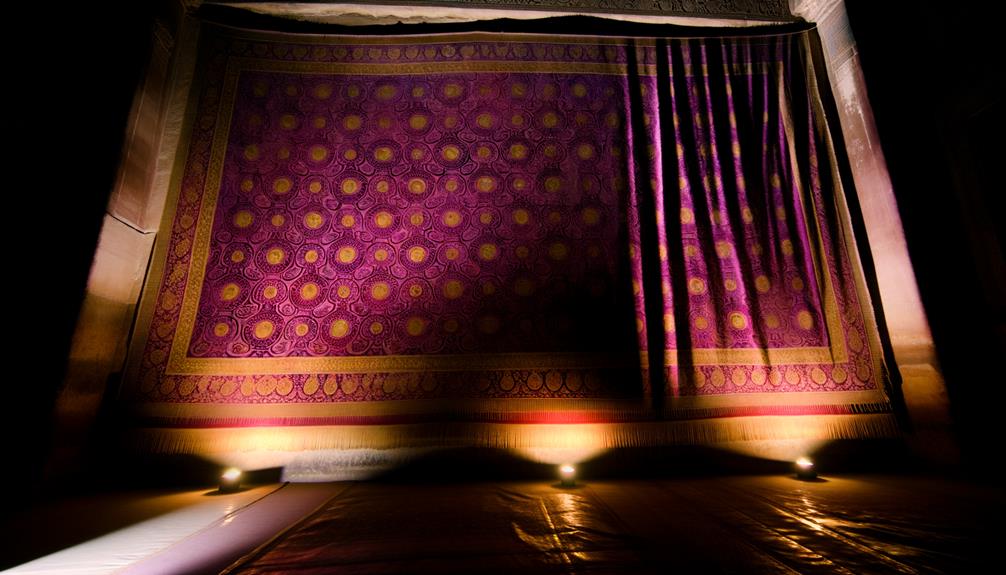
Throughout history, the color purple has been revered for its association with royalty, nobility, and spiritual wisdom.
Originating from rare and expensive dyes, purple was often seen in religious contexts, symbolizing a deep connection to the divine. In ancient civilizations, such as Egypt and Rome, purple was used in sacred rituals and worn by high priests, signifying their elevated spiritual status.
Additionally, purple’s unique blend of red’s passion and blue’s tranquility has long been interpreted as a balance of power and serenity, making it an emblem of spiritual harmony.
The color’s historical significance transcends cultures and epochs, consistently representing a bridge between the earthly and the ethereal, a reflection of its enduring spiritual resonance.
Royalty and Nobility
The color purple has long been synonymous with royalty and nobility, symbolizing wealth, power, and prestige across various cultures and historical periods.
In ancient times, purple dye was incredibly rare and expensive, extracted from the secretions of sea snails, making it accessible only to the elite. This exclusivity cemented purple as a marker of high status, often reserved for monarchs and high-ranking officials.
European royalty, including emperors and kings, embraced purple garments as a visual declaration of their sovereignty and divine right to rule.
The association of purple with the highest echelons of society endures today, reflecting the historical legacy of its rich, luxurious connotations.
Understanding this context enriches our appreciation of purple’s profound cultural impact.
Spiritual Symbolism

While its historical ties to royalty and nobility are well-documented, purple also holds a profound spiritual symbolism that transcends its material associations.
In spiritual contexts, purple is often associated with higher states of consciousness, inner wisdom, and spiritual growth. It is considered a bridge between the physical and the divine, encouraging introspection and deeper understanding.
Many spiritual traditions regard purple as a color of transformation and enlightenment, symbolizing the journey towards self-realization and cosmic awareness. The hue serves as a visual reminder of the vast, unseen dimensions of existence and the potential for spiritual ascension. In contrast, the spiritual significance of the color white represents purity, clarity, and a state of enlightenment that transcends the complexities of the material world. It is often associated with new beginnings and the shedding of old patterns, creating a space for renewal and growth. Together, purple and white embody a duality of transformation, merging the depths of introspection with the brightness of clarity and hope. Additionally, purple often complements other colors that carry their own meanings, such as the spiritual significance of the color red, which represents passion and vitality. Together, these colors create a dynamic interplay that can enhance one’s spiritual practice and deepen the understanding of life’s complexities. Embracing these hues can help individuals tap into their inner potential and foster a greater connection with the universe. In this context, the spiritual significance of rainbow colors becomes apparent, as each hue represents different facets of life and consciousness. From the grounding energy of red to the calming essence of blue, these colors collectively illustrate the spectrum of human experience and the interconnectedness of all beings. Embracing the full range of these colors invites individuals to explore their own paths to enlightenment and deeper understanding.
Consequently, purple’s spiritual significance extends far beyond its regal history, touching the very essence of human spirituality and consciousness.
Chakra Connection
In the domain of chakra healing, the color purple is intrinsically linked to the crown chakra, also known as Sahasrara, which represents the pinnacle of spiritual connection and enlightenment. Situated at the top of the head, this chakra is considered the gateway to higher consciousness and divine wisdom, fostering unity and transcendence.
| Aspect | Description |
|---|---|
| Chakra Name | Crown Chakra (Sahasrara) |
| Location | Top of the Head |
| Element | Thought |
| Associated Color | Purple/Violet |
| Governing Aspects | Spirituality, Enlightenment, Unity |
The color purple, consequently, symbolizes a journey towards self-realization and a deeper understanding of the universe. Aligning with this chakra can bring about profound transformation, guiding individuals towards a state of inner peace and universal awareness.
Meditation and Healing
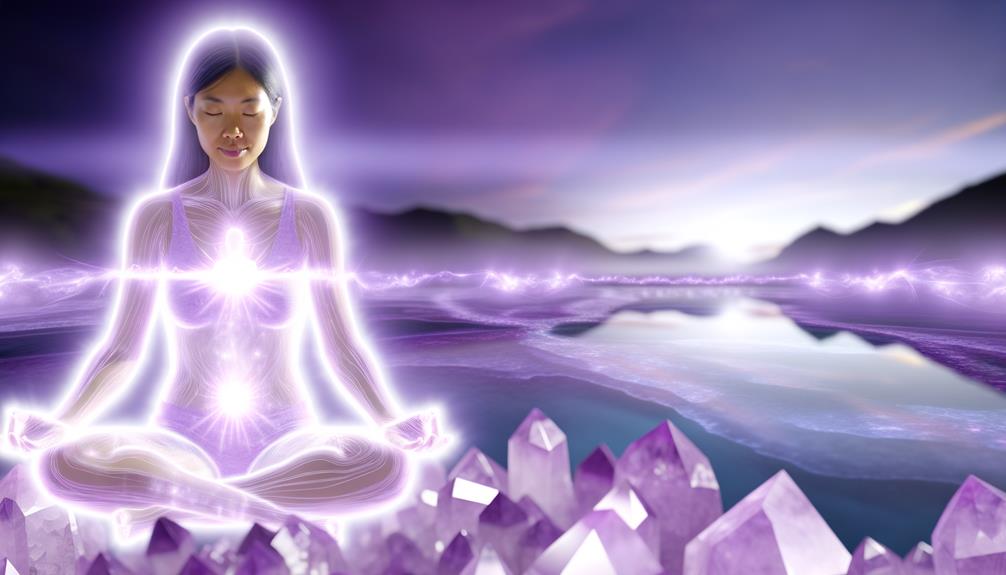
Building upon the profound connection of the color purple with the crown chakra, meditation and healing practices harness this vibrant hue to facilitate spiritual growth and inner tranquility.
Purple is often used in guided meditations to open the mind to higher consciousness and divine wisdom. Practitioners may visualize a purple light enveloping them, aiding in stress reduction and emotional healing.
The color’s high-frequency vibration is believed to cleanse negative energies, fostering a sense of peace and well-being. Additionally, purple crystals, such as amethyst, are often incorporated into healing rituals to enhance spiritual insight and promote mental clarity.
Through these practices, individuals can achieve a deeper connection with their inner selves and the universe.
Religious Contexts
In many religious traditions, the color purple is imbued with profound significance, symbolizing both royalty and divinity. It is often associated with mysticism and the quest for enlightenment, reflecting a bridge between the earthly and the spiritual domains.
This rich hue is frequently used in sacred rituals and vestments, underscoring its connection to the divine and the transcendent.
Royalty and Divinity
The color purple has long been intertwined with notions of royalty and divinity, often symbolizing spiritual authority and sacredness in various religious contexts.
In ancient times, purple dye was rare and expensive, making it a symbol of nobility. Within religious traditions, it represents divine power and sanctity.
In Christianity, purple is used during Advent and Lent, periods of penance and reflection. Similarly, in Hinduism, purple is associated with divine energy and the Crown Chakra, which connects individuals to higher spiritual domains.
This rich hue therefore transcends mere aesthetics, embodying a deeper spiritual resonance that commands respect and reverence.
Purple remains a symbol of both earthly and heavenly majesty, bridging the human and the divine.
Mysticism and Enlightenment
Throughout various religious contexts, the color purple has been revered as a symbol of mysticism and enlightenment, often representing a profound connection to the spiritual sphere.
In Christianity, purple is traditionally associated with Lent and Advent, periods of contemplation and preparation for divine mysteries.
In Eastern philosophies, such as Buddhism and Hinduism, purple signifies the crown chakra, which is linked to higher consciousness and spiritual awakening.
The hue’s deep, rich quality is thought to open pathways to inner wisdom and transcendent experiences.
This color’s resonance with the divine domain invites individuals to seek deeper truths and cultivate a sense of inner peace and understanding, bridging the gap between the material and the ethereal.
Modern Interpretations
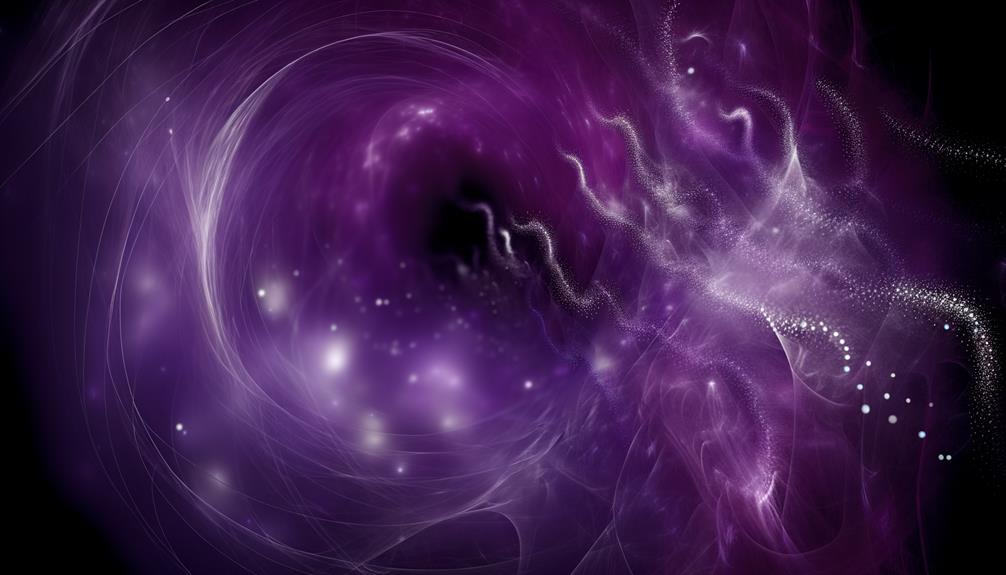
Modern interpretations of the color purple often associate it with themes of spirituality, creativity, and emotional depth.
In contemporary contexts, purple is seen as a bridge between the physical and metaphysical, embodying a sense of mystery and transformation. It is frequently used in therapeutic settings to facilitate mental clarity and emotional healing.
Artists and creatives are drawn to purple for its ability to stimulate imagination and innovation. Additionally, the color is linked to a higher state of consciousness and introspection, encouraging individuals to explore their inner worlds.
Whether in art, fashion, or interior design, purple’s modern significance is deeply rooted in its capacity to inspire, heal, and connect the human spirit to a greater sense of purpose.
Conclusion
The color purple, a tapestry woven with threads of historical significance, spiritual symbolism, and modern interpretations, resonates profoundly across cultures and epochs.
As a symbol of royalty and nobility, it commands reverence, while its spiritual connotations connect deeply with the chakra system and meditative practices.
In religious contexts, purple serves as a bridge between the earthly and the divine.
This multifaceted hue, rich in meaning, continues to inspire and elevate the human spirit.

